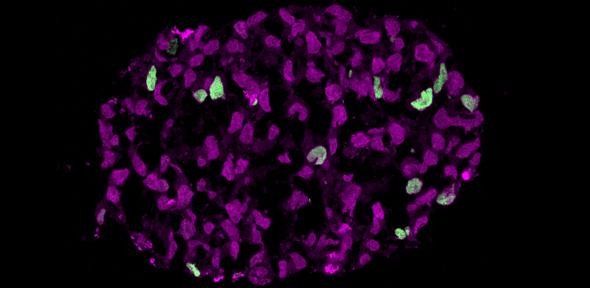Breakthrough Could Lead to Sperm and Ova being Produced in Labs
| Ana Verayo | | Dec 26, 2014 01:17 AM EST |
(Photo : Walfred Tang (University of Cambridge)) Embryoid at start of appearance of SOX17 positive cells (green cells), which depict birth of human germ cell lineage.
A team of scientists from Israel and the U.K. said they've succeeded in reverting adult cells into primordial human germ cells, a breakthrough that could help infertile couples conceive.
These reverted adult cells give rise to sperm and ova. Scientists say this is the first time human cells have been reverted to this early developmental stage.
Like Us on Facebook
The achievement was announced by teams at the Weizmann Institute of Science in Israel and Cambridge University in the U.K.
Dr. Jacob Hanna of the Institute's Molecular Genetics Department who led the study said primordial germ cells are only the first step in a process that could one day result in making sperm and ova in test tubes.
Dr. Hanna believes this step is doable, and will theoretically mean women that have undergone chemotherapy or premature menopause will be able to conceive.
"Researchers have been attempting to create human primordial germ cells in the petri dish for years," he said.
Cellular differentiation begins when germ cells that give rise to sperm and ova are created. The process developed by the Israeli and British scientists subdued the genetic mechanism responsible for cellular differentiation.
Study lead author Naoko Irie from the University of Cambridge said scientists have recreated this early stage of development with stem cells with mice and rats but this is the first time human stem cells have been used.
Human primordial germ cells (PGCs) form during the early weeks of embryonic growth in which embryonic stem cells in the fertilized egg begin to differentiate from other human cells. When these primitive cells differentiate into sperm cells or ova, they will continue to do so as if on autopilot.
Researchers worked with naive human embryonic stem and pluripotent stem cells using a new method that reproduced cells identical to human PGCs.
The experiment showed that 40 percent of the stem cells turned into human sperm and ova, making this the first time scientists created a sperm and egg cell.
This study was published in the journal, Cell.
TagsScientists Create First Artificial Human Sperm and Egg Cell, University of Cambridge, scientists create artificial egg sperm cell infertility treatment
©2015 Chinatopix All rights reserved. Do not reproduce without permission
EDITOR'S PICKS
-

Did the Trump administration just announce plans for a trade war with ‘hostile’ China and Russia?
-

US Senate passes Taiwan travel bill slammed by China
-

As Yan Sihong’s family grieves, here are other Chinese students who went missing abroad. Some have never been found
-

Beijing blasts Western critics who ‘smear China’ with the term sharp power
-

China Envoy Seeks to Defuse Tensions With U.S. as a Trade War Brews
-

Singapore's Deputy PM Provides Bitcoin Vote of Confidence Amid China's Blanket Bans
-

China warns investors over risks in overseas virtual currency trading
-

Chinese government most trustworthy: survey
-

Kashima Antlers On Course For Back-To-Back Titles
MOST POPULAR
LATEST NEWS
Zhou Yongkang: China's Former Security Chief Sentenced to Life in Prison

China's former Chief of the Ministry of Public Security, Zhou Yongkang, has been given a life sentence after he was found guilty of abusing his office, bribery and deliberately ... Full Article
TRENDING STORY

China Pork Prices Expected to Stabilize As The Supplies Recover

Elephone P9000 Smartphone is now on Sale on Amazon India

There's a Big Chance Cliffhangers Won't Still Be Resolved When Grey's Anatomy Season 13 Returns

Supreme Court Ruled on Samsung vs Apple Dispute for Patent Infringement

Microsoft Surface Pro 5 Rumors and Release Date: What is the Latest?










